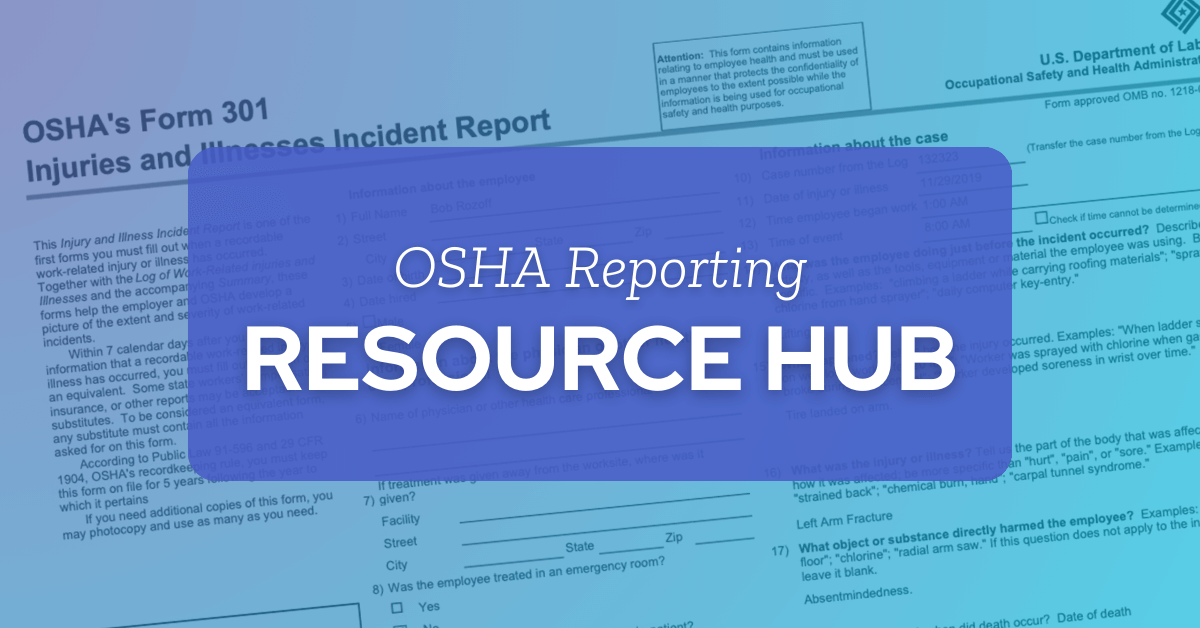One of your employees just got hurt. You need to take action—fast.
We’re not only talking about administering first aid or seeking medical attention. If you fail to record and report the event to the Occupational Health and Safety Administration, your organization could face serious fines and—worse—place other workers in danger.
In the interest of helping you protect your workforce and bottom line, we’ve put together an action plan for recording and reporting injuries and illnesses to OSHA.
Let’s return to the scene and our wounded employee. Assuming you’re not exempt from OSHA recordkeeping requirements, here’s what you need to do next:

If regulatory paperwork makes your head spin, have no fear—the workforce safety and compliance professionals at KPA are here to help. We’ve created this resource hub chock full of OSHA recordkeeping and reporting best practices to help keep your head on straight.
Is it work-related?
Some injuries and illnesses that seem to happen in the workplace are not, in fact, work-related incidents as far as OSHA is concerned. The following are examples of non-work-related injuries and illnesses do not need to be recorded:
- injuries that occur to the general public
- certain parking lot accidents
- non-work-induced mental illnesses
- colds and cases of flu
- injuries that arise from personal meals or grooming
- injuries that are self-inflicted or from self-medication
- injuries occurring on the premises due to outside factors (such as a natural disaster)
What counts as “first aid?”
OSHA makes distinctions between illnesses and injuries that can be adequately treated with first aid and those incidents that require further medical attention. Sometimes the distinction is obvious: Removing a splinter? You probably don’t need to record it. Amputating a finger? You probably should record that.
Other times, as in assessing the difference between administering a tetanus shot and another immunization, the situation demands knowledge of OSHA’s particular rules around first aid.
Generally speaking…
- Easily treatable injuries don’t need to be recorded. Examples of sufficient first aid treatments include splinter removal, the use of finger guards, drinking fluids for relief of heat stress, and hot and cold therapy, as well as the process of cleaning, flushing, and soaking wounds.
- You don’t need to record the use of nonprescription medications, such as aspirin and other over-the-counter treatments.
- You technically don’t need to record the use of eye patches—although it’s more than likely that any injury or illness involving the eye will turn out to be a recordable case.
For OSHA’s full list of what counts as “first aid,” click here.
Fatalities must be reported to OSHA within 8 hours.
Serious injuries must be reported to OSHA within 24 hours. Examples of serious injuries include…
- Any in-patient hospitalization of one or more employees as a result of a work-related incident. This encompasses all formal admissions to the in-patient service of a hospital or clinic for care or treatment. Note that hospitalization doesn’t necessarily mean that the employee stays overnight; if they’ve been admitted for in-patient treatment, the event must be reported.
- Any employee amputation as a result of a work-related incident. An amputation is defined as the traumatic loss of a limb or other external body part. This includes full and partial amputations—parts that have been severed, cut off, fingertip amputations (with or without bone loss), medical amputations resulting from irreparable damage, and amputations of body parts that have since been reattached. Non-amputations include avulsions (tissue torn away from the body), enucleations (removal of the eyeball), deglovings (skin torn away from the underlying tissue), scalpings, severed ears, and broken or chipped teeth.
- Any employee loss of an eye as a result of a work-related incident.
If a fatality occurs within 30 days of the work-related incident, or if a serious injury occurs within 24 hours of the work-related incident, you must also report the event to OSHA.
When reporting an incident, be sure to include the following information:
- the establishment name
- the location of the work-related incident
- the time of the work-related incident
- the type of reportable event (e.g. fatality, in-patient hospitalization, amputation, or loss of an eye)
- the names and number of employees who suffered a fatality, in-patient hospitalization, amputation, or loss of an eye
- your contact person and their phone number
- a brief description of the work-related incident
You have three options for filing a report:
- by telephone, to your OSHA area office
- by telephone, to the 24-hour OSHA hotline (1-800-321-OSHA or 1-800-321-6742)
- electronically, using the reporting form at OSHA.gov
Keep in mind that your organization may have different requirements depending on your state. Be sure to check your local OSHA office’s standards and regulations.
Last, if your area office is closed, you must report a fatality, in-patient hospitalization, amputation, or loss of an eye by phone or electronically.
Don’t let OSHA recordkeeping requirements take more time and energy than necessary.
KPA makes OSHA electronic reporting—and all elements of OSHA compliance and workforce health and safety—as easy as possible. Complete and file OSHA Forms 301, 300, and 300A quickly and accurately with KPA EHS Software.
Learn how we can save you time and money. Take a Test Drive >>
Related Content
Explore more comprehensive articles, specialized guides, and insightful interviews selected, offering fresh insights, data-driven analysis, and expert perspectives.
